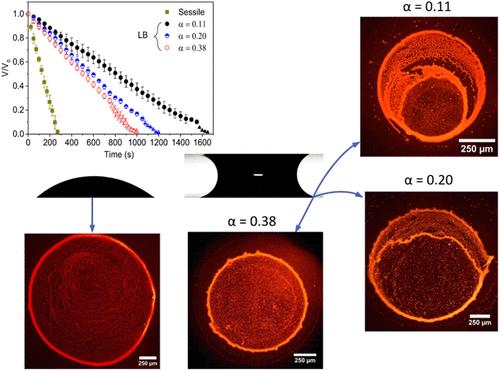载菌液体桥的瞬态动力学研究
IF 3.9
2区 化学
Q2 CHEMISTRY, MULTIDISCIPLINARY
引用次数: 0
摘要
通过实验和理论分析研究了载菌液桥的蒸发机理和沉淀特性。在受污染的食物和水中常见的活动和非活动的鼠伤寒沙门菌和铜绿假单胞菌的水悬浮液被用于亲水性基质之间的液体桥结构。利用反对数蒸发通量模型,研究了不同约束距离下柱状和链状体积模型的液桥体积回归。我们证明了对于所有约束距离,体积回归在归一化体积和时间上都是线性的,就像在纯无底滴的情况下一样。然而,在归一化体积和维时间空间中,我们观察到一些非线性现象,即总蒸发时间随约束距离呈非线性变化。发现的非线性是用链状模型捕获的。圆柱体积模型无法捕捉到回归趋势,而链状体模型符合所有约束距离下的实验体积回归数据以及高约束距离下的瞬态液桥界面演化曲线。此外,我们还利用微纳米表征技术研究了沉淀模式和细菌分布。我们表明,尽管潜在的细菌分布不同,但无底座和较高限制距离的平均沉淀模式类似于咖啡环型沉积物。对于较低约束,我们观察到由咖啡环效应、粘滑运动和薄膜不稳定性联合产生的模式。限制距离的减小引起细菌聚集的改变,导致多模式网络而不是单一的周向边缘沉积。我们发现,随着限制的减少,活动细菌的空中大小增加,而非活动细菌的大小在沉淀中保持不变。这些发现对医院环境中人类发病机制的建立有了至关重要的理解。本文章由计算机程序翻译,如有差异,请以英文原文为准。

Insights into Transient Dynamics of Bacteria-Laden Liquid Bridges
We study the evaporation mechanics and precipitate characterization of the bacteria-laden liquid bridge using experimental and theoretical analysis. Aqueous suspensions of motile and nonmotile Salmonella typhimurium and Pseudomonas aeruginosa typically found in contaminated food and water were used in liquid bridge configuration between hydrophilic substrates. Using the inverse logarithmic evaporation flux model, we study the liquid bridge volume regression using cylindrical and catenoid volume models for various confinement distances. We show that for all confinement distances the volume regression is linear on normalizing both volume and time as in the case of a pure sessile drop. However, in normalized volume and dimensional time space we observe some nonlinearities as the total evaporation time scales non linearly with the confinement distance. The nonlinearities found were captured using the catenoid model. The cylindrical volume model fails to capture the regression trend, whereas the catenoid model conforms to the experimental volume regression data at all confinement distances and the transient liquid bridge interface evolution profile at a high confinement distance. Further, we also study the precipitate pattern and bacterial distribution using micro/nanocharacterization techniques. We show that the average precipitate pattern for both sessile and higher confinement distances resembles coffee-ring-type deposits, although the underlying bacterial distribution differs. For lower confinement, we observe a pattern resulting from a combination of the coffee-ring effect, stick-slick motion, and thin film instability. The reduction in confinement distance causes an altered bacterial agglomeration, resulting in a multipattern network instead of a single circumferential edge deposition. We show that the aerial size of motile bacteria increases with decreasing confinement, whereas the size of nonmotile bacteria remains constant in the precipitate. These findings have a crucial understanding of the establishment of pathogenesis in humans in hospital settings.
求助全文
通过发布文献求助,成功后即可免费获取论文全文。
去求助
来源期刊

Langmuir
化学-材料科学:综合
CiteScore
6.50
自引率
10.30%
发文量
1464
审稿时长
2.1 months
期刊介绍:
Langmuir is an interdisciplinary journal publishing articles in the following subject categories:
Colloids: surfactants and self-assembly, dispersions, emulsions, foams
Interfaces: adsorption, reactions, films, forces
Biological Interfaces: biocolloids, biomolecular and biomimetic materials
Materials: nano- and mesostructured materials, polymers, gels, liquid crystals
Electrochemistry: interfacial charge transfer, charge transport, electrocatalysis, electrokinetic phenomena, bioelectrochemistry
Devices and Applications: sensors, fluidics, patterning, catalysis, photonic crystals
However, when high-impact, original work is submitted that does not fit within the above categories, decisions to accept or decline such papers will be based on one criteria: What Would Irving Do?
Langmuir ranks #2 in citations out of 136 journals in the category of Physical Chemistry with 113,157 total citations. The journal received an Impact Factor of 4.384*.
This journal is also indexed in the categories of Materials Science (ranked #1) and Multidisciplinary Chemistry (ranked #5).
 求助内容:
求助内容: 应助结果提醒方式:
应助结果提醒方式:


